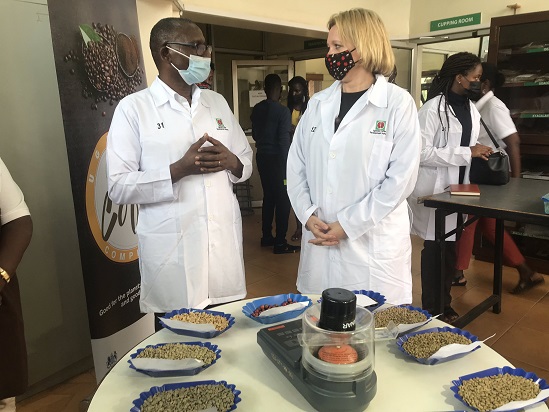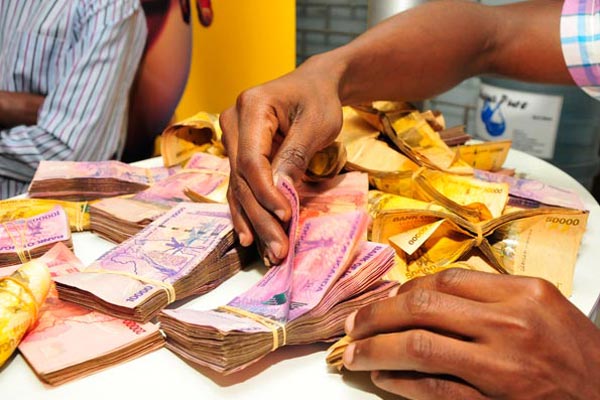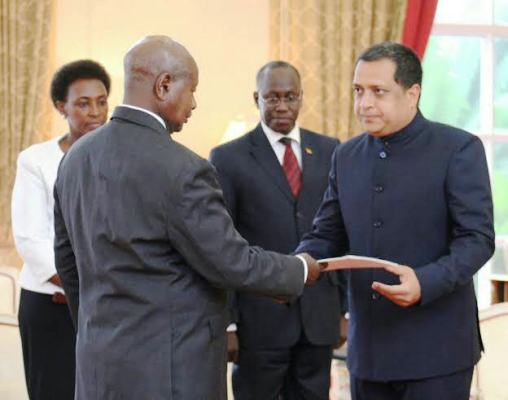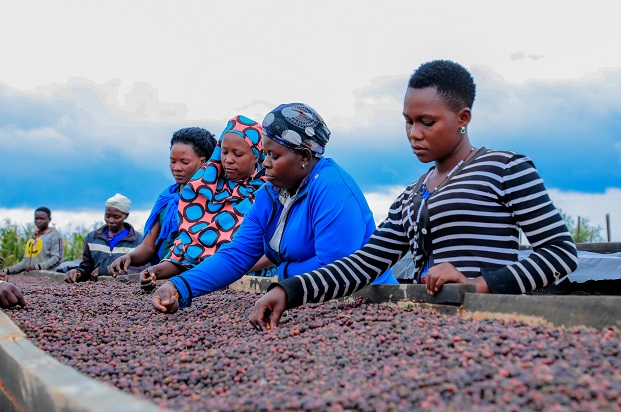UCDA MD, Dr. Emmanuel Iyamulemye (Left) and British High Commissioner to Uganda, Kate Airey discuss coffee samples (on the table) at the UCDA lab at UMA, Lugogo recently.
Uganda’s Coffee exports for the 12 months (Financial year 2020/21) amounted to 6,078,638 60-kilo bags worth US$ 559.26 million compared to 5,105,881-kilo bags valued at US$ 496.28 million the previous year (Financial Year 2019/20).
However, before these exports are made, a lot goes on to ensure quality and standards are observed.
This is done by the Uganda Coffee Development Authority (UCDA) and the Directorate of Quality Assurance in particular.
According of Juliet Nanyonga, a Quality Assurance Officer at UCDA, a good cup of coffee starts on the farm “because what you put in, is what you get.”
“So, you have to start from the seedlings, applying good agronomic practices, applying fertilizers and proper post harvest handling; only ripe (red) cherries should be harvested/ picked from the trees. So, after harvesting, depending on the market requirements, a farmer or a buyer may choose to process the coffee. We have the two processing methods – the dried or natural and the washed method,” Nanyonga explains.
For natural method, she says, coffee is exposed to the sun to dry with its natural cover.
“Coffee is dried up to 13% moisture,” she says.
“It is then delivered to primary facilities for milling (commonly called hurling) to remove the skin (husk). So, what we get out is ungraded coffee. Fairly Average Quality (FAQ) coffee (commonly known as kase) is what is delivered to export factories for secondary processing,” Nanyonga says.
At secondary processing, she says, “coffee is cleaned and graded according to bean size. The graders have different size screens ranging from 19 to 12 but in Uganda, the exportable grades have screen 18 up to screen 12 (for Robusta).”
After grading, a licensed coffee exporter sends a formal request to UCDA.
“So, when the request is made, UCDA will go, sample the coffee, and bring it to the lab for analysis,” she says.
She adds that when the samples are brought to the lab (UCDA’s modern lab is based at UMA Show Grounds, Lugogo), it is decoded (blind grading).
“We don’t know which company so we do blind grading,” Nanyonga says.
Depending on the grade an exporter specifies, the Quality Assurance team subjects the coffee to grading by size.
“For example, if it is screen 15, the coffee must meet 90% for the respective screen indicated which is screen 15. So, I do the shaking (in the factory by vibration). When the coffee passes the test, it is confirmed as indicated by the exporter,” she says.
Thereafter, a moisture check is carried out.
“For Robusta, it’s 12.5% maximum or below,” Nanyonga says.
So, she explains: “that means that the consignment meets the requirements. So, we inform the exporter to schedule the container and the logistics and then we go and load it, seal it and issue a certificate after which coffee can move out of the country.”





